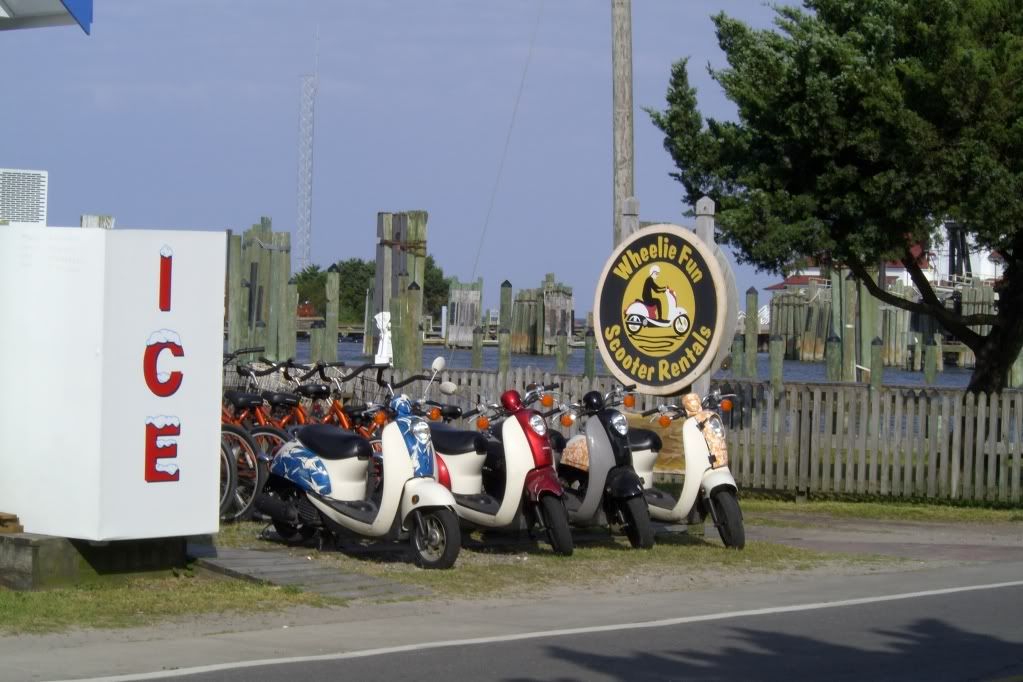
There is an island halfway between Key West and Nantucket in nature and atmosphere.
Ocracoke on the Outer Banks is still truly an island. Unlike Hatteras or the other islands, it can only be reached by ferry, and there isn't a whole lot of land to go around.
Only 14 miles long, it was mostly sandbar except for its southern point until the Park Service tried to save its beaches by constructing giant dunes. The Park Service took over most of the island when the Cape Hatteras National Seashore was created in the 1930s, though the island is in a completely different county in N. Carolina than the islands above it or below it. (In fact it is the richest town in its county, but the people are bitter because they pay the highest taxes than any other residents and get few to no services. Hey, they're an island. It's hard to get basics like trash pickup. It has to all go to or come from the mainland.)
We went at the end of the off season, which was good for us since we hadn't reserved anything. The island has only 800 year round residents, but a lot of rental houses and hotels that fill up quickly during the summer. It's best to reserve ahead of time if you plan to visit between Memorial Day and Labor Day, or you'll find yourself stuck.
They have a National Park Visitor's Center that can help you with everything (the park service workers are all locals so they know the place intimately). They also offer tours about shipwrecks, the lighthouse, pirates and more for free. The Park Service visitor's center is in the village next to the Coast Guard Station and ferry docks. The Coast Guard Station, is no longer in active use since 1996.
The locals consider the tourist draw a blessing and a curse. Many work two to three jobs during the summer and take off for the winter season. But those jobs help them keep their homes, which many have been priced out of in the recent land speculation that caused the housing bubble.
Even today many houses are listed around half a million. (But if you don't mind buying a house to fix up, the Ocracoke Conservation Association is selling two historic houses for around $200,000. Cheap by island standards.)
So what does this have to do with scooters?
Well, the streets are narrow and many aren't paved (they're sand with oyster shells), but scooters are a great way to get around. The business and residential area is 1,000 acres and not all of it can be fully developed (there isn't enough potable water).
So you don't really need a car to get around unless you are carting something. Most of the hotels rent bicycles, but there is a shop at the pier next to SMacNally's that rents scooters called "Wheelie Fun". It did look like someone had been driving them drunk. The front fenders were all bent and cracked. They use Honda Metropolitans.
I did see other people with tricked out scooters who must live or work there because they had meaty jams and were stylin some pretty fancy paint.
We didn't go for the scooters to get around on simply because they were expensive. (Nothing there is cheap because it all has to be shipped in.) They ran about $30 an hour. Yes, an hour.
When you are staying for a while (we were there about a week) I'd opt for the bicycle rentals at the Pony Island Hotel. It's one of the older hotels on the island and is on Route 12, which becomes the main street running through town to the harbor and ferry. Those rentals only cost $2 an hour and you could rent them for $30 for the week.

Cars are a pain on an island that small. There really is no place to turn around, the speed limit is 25 mph or less (there are people EVERYWHERE so you really have to be careful driving through town).
We rented the bikes for one day, after we got rained out of our tent and stayed at the Pony Island (Nice hotel, cheap rooms, owned by a local. Not all hotels on the island are.). It was great to leisurely ride around and not worry about parking. People don't care that you park your bike someplace but good luck finding someplace legal to park your car.
A lot of people use golf carts as well, but there's something so vacationy about riding your bike, and it's the preferred choice of islanders. (There was only one gas station, but they took it out to upgrade it and might be out all summer. You only can get gas after a ferry ride to either Hatteras or the mainland now. They warn you at the ferry to make sure you have a full tank before you get on for Ocracoke.)
Many may say there is little to do on the island. It was a fishing port and entrepot. Ocracoke, and it's neighboring island, Portsmouth (now a ghost town), were founded by an act of the state Legislature after they had too many shipwrecks from vessels trying to get through the inlet into Pamlico Sound. Even today you'd better know the area before you go sailing. The sandbars like to shift around.
 An entrepot is a harbor where large vessels dock and transfer their cargo to smaller ships to get it through shallow waters to mainland towns. Portsmouth was a popular, populated seaport in the 1700s and 1800s until new inlets farther up the Outer Banks opened up after hurricanes in the late 1800s, early 1900s. The shipping traffic went north, leaving the island towns with only fishing opportunities, but those soon died out as new, faster ways to catch fish and get it to market cheaper took over. Ocracoke first started as Pilot Town, which was located around Teach's Hole, a small sound east of the current village.
An entrepot is a harbor where large vessels dock and transfer their cargo to smaller ships to get it through shallow waters to mainland towns. Portsmouth was a popular, populated seaport in the 1700s and 1800s until new inlets farther up the Outer Banks opened up after hurricanes in the late 1800s, early 1900s. The shipping traffic went north, leaving the island towns with only fishing opportunities, but those soon died out as new, faster ways to catch fish and get it to market cheaper took over. Ocracoke first started as Pilot Town, which was located around Teach's Hole, a small sound east of the current village.
(A view of Teach's Hole, though it would have looked much different in the early 1700s when Teach put in there to party with his crew.)
The area once occupied by Pilot Town is now called Springer's Point and it is a preserved area for birds. There is a footpath you can take down to the "hole." and it gets pretty creepy. Some of the island's oldest trees are there and there are still graves, old graves, hidden in the underbrush off the path (don't go looking for them, it's discouraged) and there are old rain cisterns from the houses that used to be there still in the area. The townsfolk believe it to be one of the oldest, most haunted places on the island.
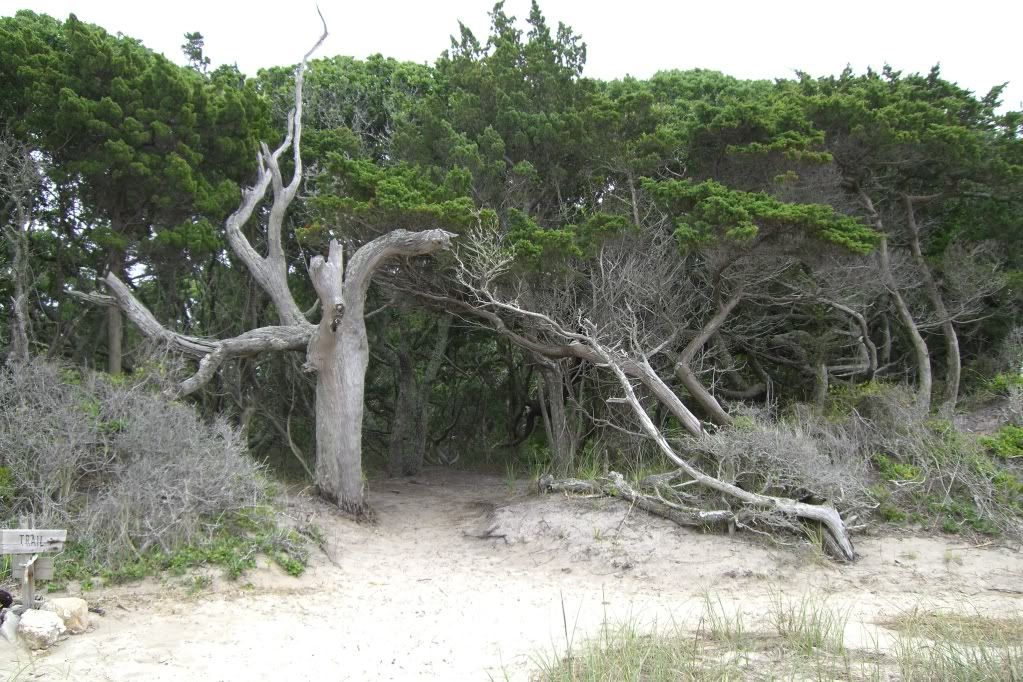
Many of the families that lived on the Point were called pointers and the other half of the islanders were called Creekers. It wasn't until the Coast Guard came and filled in the tidal creeks that separated the islanders and built a road that everyone began living near the harbor. (If the bugs on Portsmouth were any explanation, I know why they stayed away from the marshy harbor. Painful biting flies.)
Our walk to the point was quite cool yet eerie. There is a nature tour with little plaques along the way explaining the local flora, and it's a sandy trail until you get to the highest point of the island which has a large, old oak tree on it, and then you see a grave site. It's the grave of Sam Jones, who had two wives and owned the point, but was buried with his favorite horse Ike. Sam was a transplant who built two of the biggest houses on the island at the time. One is still called the mansion. But he lived on the point.
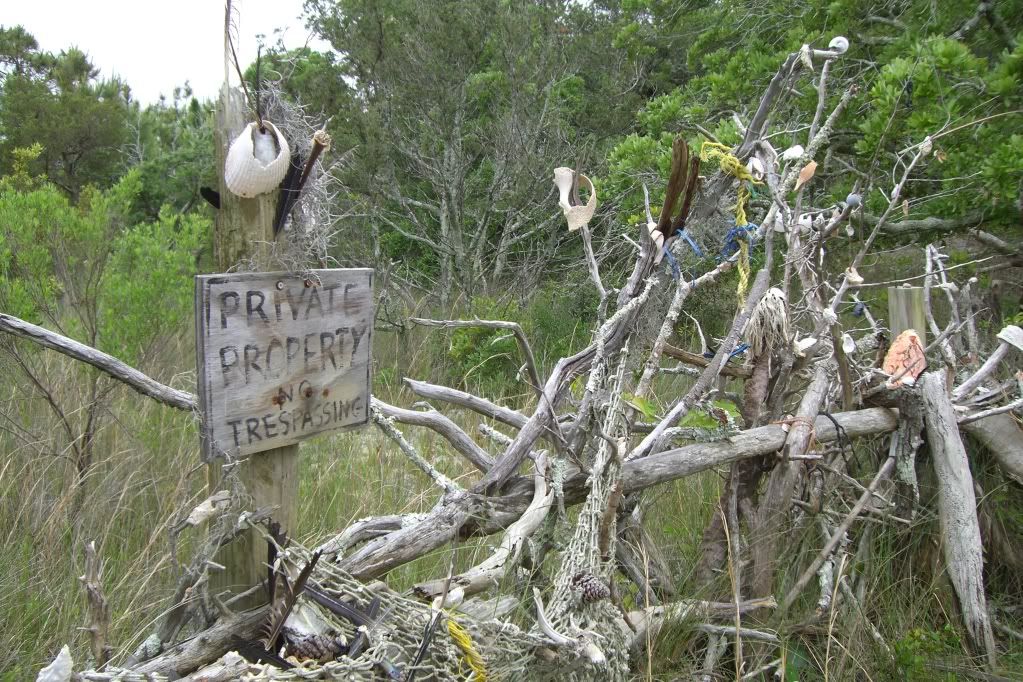
We took a ghost tour and the guide, the last of the Howard family, directly related to the first owner of the island, William Howard, who is thought to be the same William Howard who served as Blackbeard's Quartermaster before Blackbeard was killed on the island, told us that one of Sam's friends saw quite a frightening sight when he went to visit Sam's grave and clean up the area one night. Apparently it was his habit to go and keep the point in shape before it became a protected area. Kids used to go out there and drink. So this friend, Roy, took his boat around to Teach's Hole and came in on the path from the beach. (Seen in the picture above.)
As he came down the shadowy path, he saw a man sitting on the old cistern opposite Sam's grave. This man seemed funny to Roy and was dressed in old-fashioned clothing. Roy stopped and felt odd, so he decided to head back to the beach. As he started walking he heard someone behind him. When he turned around he saw the man on the cistern was coming up the path after him.
Roy began to run at this point, and when he got out to the beach, he jumped in his boat and started paddling. When he turned around he saw the man come out on the beach and walk into the water, and then he dissipated into mist.
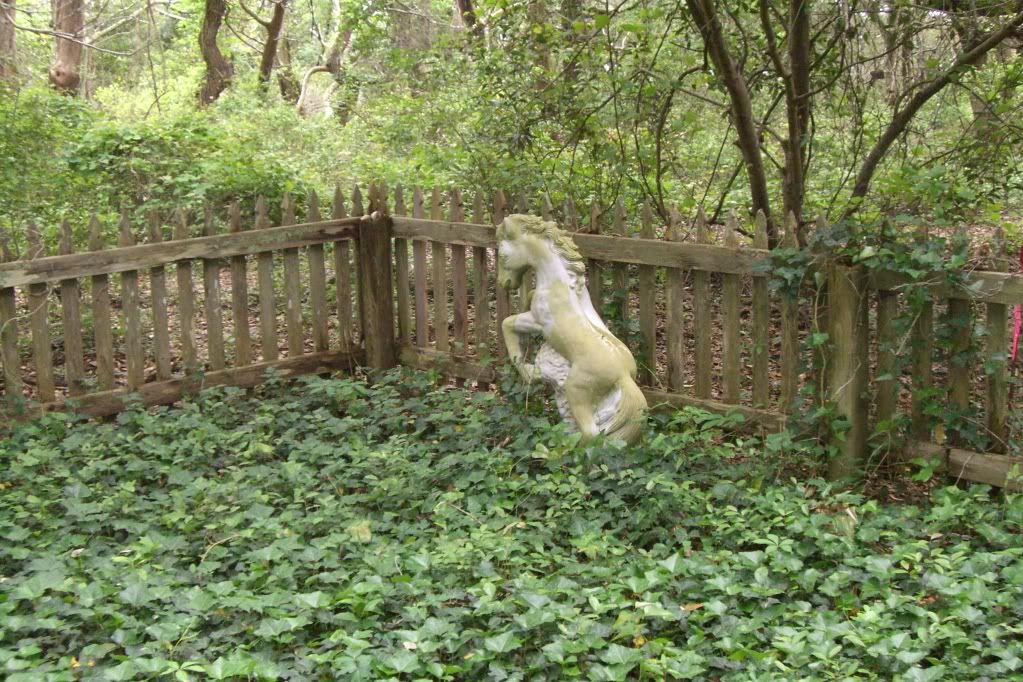 The ghost tour really was worth staying for and we did, spending our last night in a campground at the very first store in town, where the gas pumps were. We would've stayed again at the Pony Island but they were booked up for a wedding. Odd thing is the next morning, we decided to go out to the beach one last time, and as Ed flew his kite, what happens but a wedding party comes on to the beach and got married.
The ghost tour really was worth staying for and we did, spending our last night in a campground at the very first store in town, where the gas pumps were. We would've stayed again at the Pony Island but they were booked up for a wedding. Odd thing is the next morning, we decided to go out to the beach one last time, and as Ed flew his kite, what happens but a wedding party comes on to the beach and got married.Then, when Ed and I went into the water and were getting ridiculously tumbled around by the rough waves, they decided to move down to where we were and take pictures. I guarantee there is a shot with Ed and I being dragged down by the waves with weird looks on our faces in those wedding photos.
There are several places and activities I highly recommend to anyone interested in going to Ocracoke. You can, of course, go surfing, parasailing, or kayaking, renting equipment or buying lessons at one of the surf shops downtown. But you can also head out to Portsmouth Island, which we did. We took the boat tour on the dock next to Kitty Hawk Kites. There are several of these stores the length of the Outer Banks, and they have some pretty cool stuff.
They really want you to reserve for these boat rides and they need at least 3 people to go to the island because of the cost of the fuel. It runs $20 a person, but the captain will also take you past any site in the area you want to see. He took us around to Beacon Island, which once house a fort and a lighthouse before it was consumed by the waves. Oddly the sandbar that is left was visible and above water when we drove by, which Capt. Ron said was really unusual. He'd never seen it.
The island is interesting. The houses are kept in good shape by the Park Service and there are displays in some of them. I don't advise walking off the main path. We made the mistake of going to the school house and were subsequently attacked by swarms of yellow and black biting flies. (I'm still suffering from itchy bites a week later. We had bug spray and it did nothing. But they don't follow you into the houses. We don't know why.)
We ended up running down a forested path thinking we could get away from them. (The other paths through the village are flooded by the tides and you will see little holes in the sand made by little ghost crabs. I saw one scurrying away from me into the marsh. The marsh is also full of baby fish.)
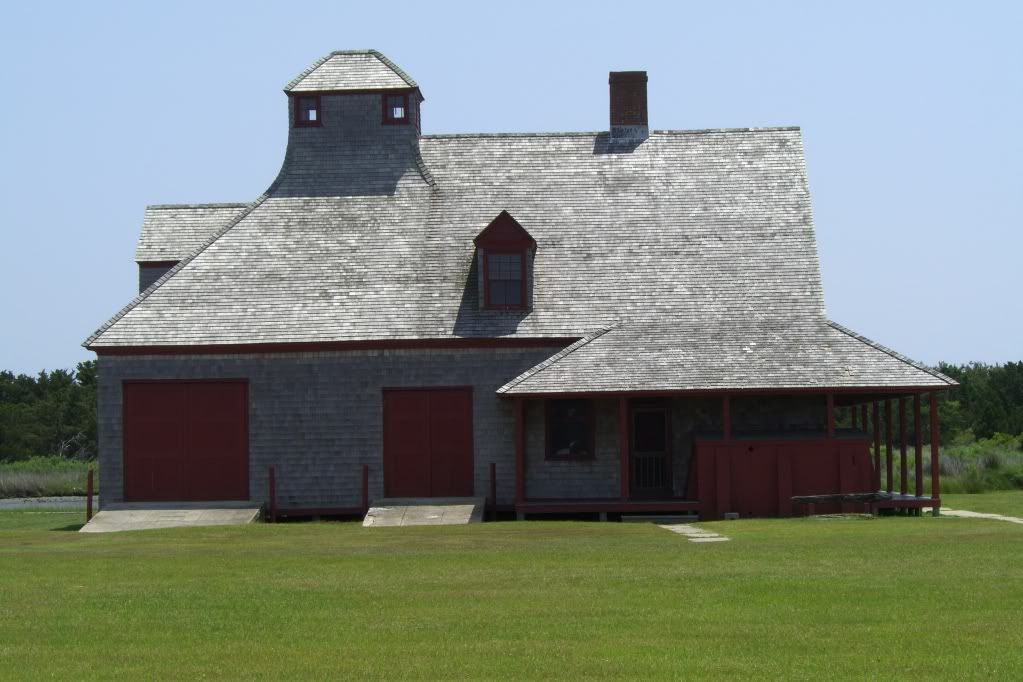
Unfortunately the flies followed us all the way to the old grass airstrip, and we were beating ourselves senseless with our hats trying to get them all off. The only park ranger on the island came riding by on an ATV and waved as we went running past screaming. Some help he was.
The life saving station is quite neat, and you can climb up to the tower and look out to Ocracoke.
We headed for the beach after leaving it hoping to get rid of the flies. Eventually we reached a wide, flat sandy area with strong ocean winds that swept the flies away. But it was a long walk around to the pickup point for our boat.

If you want to find some really awesome shells, I highly recommend heading straight for Portsmouth's beach. It's known for what washes up on it's shore: large, complete shells. Don't waste your money buying them in tourist shops. Go to Portsmouth. You can find some beautiful shells to make jewelry out of with naturally bored holes in them. Some looked like gold.
The first thing I found on the beach, which is about two miles from dunes to the sea, was half a sand dollar. Then I found a perfect one next to it. It had purple spots on the back and looked awesome, but it broke in my hand when I picked up another shell.
I wanted to look for more, but Ed was so worried about missing the boat we rushed down the beach to the pick up spot.
The beach is a real lesson in tidal islands. There are tidal pools where the birds hovered around to eat the small fish that had recently hatched. When the beach floods again the fish will be swept out to sea where they will grow larger.
The sand was carved into strange patterns by the winds and waves, and there were shell "pools" all up and down the beach.

I also recommend hanging out at SMacNally's marina on Silver Lake, which is the name of the harbor in the middle of town. You can get great burgers or seafood there and watch the boats come and cut up their fish. It's not fancy, but it's good.
I also recommend Diajio, which is down the street and has a great bar opening onto a courtyard with trees and tropical plants overshadowing it.
Then there is Zillie's, which is the local wine bar on Back Road which offers a 5 for $15 wine tasting Wednesday's at 6 p.m. They ask you reserve. We showed up but just bought a bottle of wine and hung out on their balcony. The building is three stories and has porches on the second and third floors with brushed metal tables that are great to hang out at. We met a nice couple from Chicago who'd been going to Ocracoke every spring for 10 years. They recommended the ghost tour that leaves from the Village Craftsman shop on Howard Street.
We also loved the coffee shop on Back Road, but there is also a great pastry shop on the main street as well.
The park service campground is the cheapest, but there are two others on the island, one off Back Road and the one off the main street.
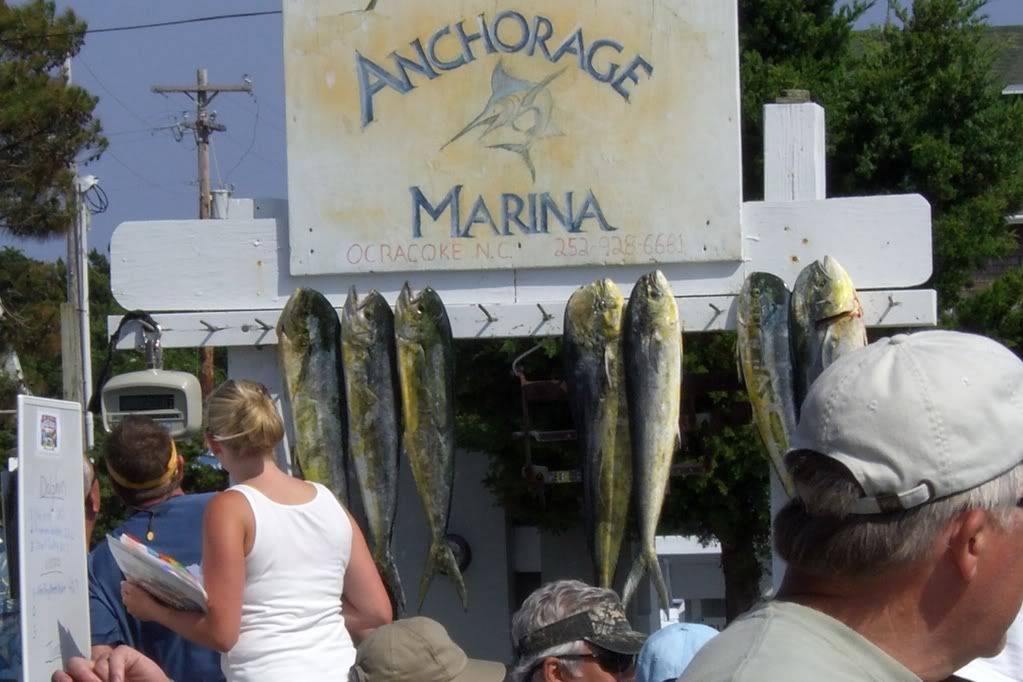 I'm not sure either has a real name, and one of them was for sale. They mostly accomodate campers who hang around for quite a while or leave their rigs there.
I'm not sure either has a real name, and one of them was for sale. They mostly accomodate campers who hang around for quite a while or leave their rigs there.The only thing I regret is not finding some flotsam. Our ghost tour guide said the locals really like to skim the beaches. Considering most of the wood for their houses came from shipwrecks I can understand why.
Our first day in Ocracoke, we went to the beach and looked around for anything that might be interesting. Ed found a piece of what must've been a ship. But we left it on the beach. You can find some really interesting things out there I'm sure, and it was a rough sea. I was hoping to find doubloons, but our ghost tour guide said that the area near the campground was the site of the wreck of the steam ship Home in which 90 people died. She said she didn't like to go to that beach because they buried the dead in the sand, and sometimes people found pieces of human bone there.
I don't know if any beach on the island could be considered ghost, or shipwreck free. It is one of the worst for them. But I think that's one of the things that make it worth visiting.
If you are heading north on your way home, don't forget to stop at the Graveyard of the Atlantic Museum. I wanted to but we didn't have time.

Next time, when we return. And I won't wait another 10 years. The island might be under water by then, or so they say, but for a sandbar, it's been around a long time. Maybe next time it will just be farther in to Pamlico Sound. Hopefully the old Pilot Town and Teach's Hole will still exist.


